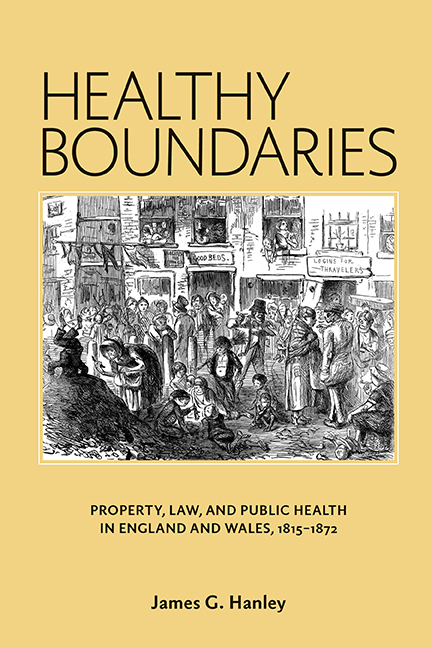Book contents
- Frontmatter
- Dedication
- Contents
- Acknowledgments
- Abbreviations
- Introduction
- 1 The Laws of Nuisance Before 1846: Property, Health, and Democracy in the Age of Reform
- 2 Private Benefit and Public Service: Paying for Sewers Before 1848
- 3 The Boundaries of Health, 1848–70
- 4 The Benefits of Health: London, 1848–65
- 5 Healthy Domesticity, 1848–72
- Conclusion
- Notes
- Bibliography
- Index
3 - The Boundaries of Health, 1848–70
Published online by Cambridge University Press: 07 May 2022
- Frontmatter
- Dedication
- Contents
- Acknowledgments
- Abbreviations
- Introduction
- 1 The Laws of Nuisance Before 1846: Property, Health, and Democracy in the Age of Reform
- 2 Private Benefit and Public Service: Paying for Sewers Before 1848
- 3 The Boundaries of Health, 1848–70
- 4 The Benefits of Health: London, 1848–65
- 5 Healthy Domesticity, 1848–72
- Conclusion
- Notes
- Bibliography
- Index
Summary
The previous chapter showed that the physical boundaries of drainage were increasingly controversial in both London and the provinces. In this chapter, I analyze boundary-making processes under the 1848 Public Health Act (PHA). I demonstrate that boundaries, for both opponents and supporters of the PHA, were not simply physical or administrative. They were simultaneously political, ideological, and financial, defining not only membership but responsibility and, more important, liability. In the course of boundary making, local PHA promoters and local boards of health developed a view of public health that amounted to a new view of community, integrating spatially, socially, and functionally distinct kinds of property into a common political and financial regime. In legal terms, this was controversial, but in contrast to the situation under the Tudor Law of Sewers, local promoters successfully persuaded the courts to expand the circle of liability. In this case, as in the creation of the statutory health hazard, public health activists changed the law of property's liability.
The PHA was one of several laws enacted in the first half of the nineteenth century that had significant boundary-making implications. The 1832 Reform Act, the 1834 New Poor Law, and the 1835 Municipal Reform Act also demanded spatial reorganization. These acts required some kind of physical boundary, often a novel one, for parliamentary constituencies, poor law unions, or municipal corporations. Boundary making was hardly the primary purpose of these acts, but it was inextricably linked to all of them. Parliament clearly recognized the importance and sensitivity of the matter, devoting significant parliamentary time to the discussion of boundaries and insisting for the 1832 and 1835 acts that it alone could establish or change them. As a result of these boundary-making exercises, spatial and hence political and financial relationships among the country's rural, urban, and suburban populations changed in highly significant ways.
It was, perhaps, predictable that boundaries emerged as a topic of parliamentary interest during the 1830s merely as a result of the growth of cities. Yet urban areas had experienced significant population growth for decades, and Parliament previously had discussed boundaries only infrequently. Rather, politics and especially parliamentary reform in 1832 drove the increasing parliamentary concern with boundaries.
- Type
- Chapter
- Information
- Healthy BoundariesProperty, Law, and Public Health in England and Wales, 1815–1872, pp. 65 - 88Publisher: Boydell & BrewerPrint publication year: 2016



